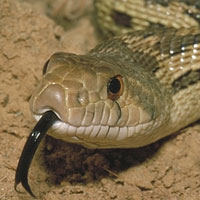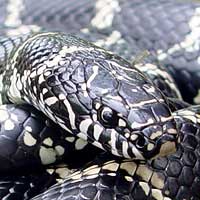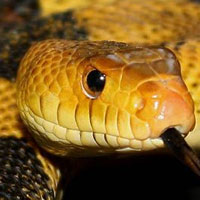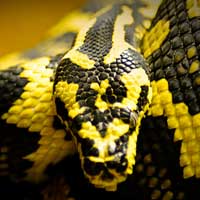Discover the Stunning Bluestripe Ribbon Snake
The scientific name of the Bluestripe Ribbon Snake is Thamnophis sauritus nitae, a subspecies of the ribbon snake. It belongs to the Colubridae family, which is the largest snake family and includes many non-venomous species.
Scientific Name: Thamnophis sauritus nitae
Snake Family: Colubridae
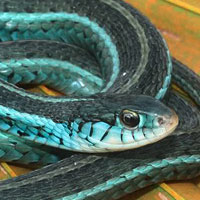
Introducing the Bluestripe Ribbon Snake
The Bluestripe Ribbon Snake (Thamnophis sauritus nitae) is a striking subspecies of the ribbon snake, known for its vibrant blue stripes running along its sleek body. This non-venomous snake is native to the southeastern United States, often found near aquatic habitats. Its slender build, active nature, and manageable care requirements make it a favorite among reptile enthusiasts. In this guide, we’ll cover its natural habitat, diet, behavior, and how to care for this captivating species.
Where Does the Bluestripe Ribbon Snake Live?
The Bluestripe Ribbon Snake thrives in wetland environments such as marshes, ponds, and streams. Its preference for areas near water is due to its diet and thermoregulation needs. In the wild, you’ll often find them basking near water edges or hiding in dense vegetation.
To create an ideal habitat in captivity, consider the following:
- Temperature: Maintain a gradient of 75-85°F with a basking spot reaching 90°F.
- Humidity: Keep humidity between 50-70% to mimic its natural environment.
- Enclosure: A 3x2x2-foot enclosure with aquatic features and plenty of hiding spots is ideal.
| Habitat Feature | Requirement |
|---|---|
| Temperature Gradient | 75-90°F |
| Humidity | 50-70% |
| Enclosure Size | Minimum 3x2x2 feet |
What Does the Bluestripe Ribbon Snake Eat?
The Bluestripe Ribbon Snake is a carnivorous species, with a diet primarily consisting of small amphibians, fish, and invertebrates. In captivity, providing a varied and balanced diet is essential for its health.
Key feeding tips:
- Prey Items: Feed small fish, earthworms, and amphibians such as frogs or tadpoles.
- Feeding Frequency: Juveniles should eat every 3-4 days, while adults can be fed every 5-7 days.
- Diet Variety: Occasionally offer insects like crickets to ensure a balanced diet.
- Supplements: Dust prey with calcium and vitamins to prevent nutritional deficiencies.
Behavior and Temperament of the Bluestripe Ribbon Snake
The Bluestripe Ribbon Snake is an active and curious species, often observed exploring its surroundings or basking. Its diurnal nature means it is most active during the day. While generally docile, it can display defensive behaviors when stressed or threatened.
Behavioral traits to note:
- Activity Level: Highly active and enjoys climbing and swimming.
- Defensive Mechanisms: May release a musky odor or flee when feeling threatened.
- Social Behavior: Typically solitary, but can coexist with other ribbon snakes in spacious enclosures.
Health and Lifespan of the Bluestripe Ribbon Snake
With proper care, the Bluestripe Ribbon Snake can live up to 10 years in captivity. Maintaining optimal environmental conditions and monitoring for signs of illness are critical for its longevity.
Common health concerns include:
- Respiratory Infections: Often caused by incorrect humidity or temperature levels.
- Shedding Problems: Ensure proper humidity to prevent retained shed.
- Parasites: Regularly inspect for mites and other external parasites.
- Nutritional Deficiencies: Provide a varied diet and use supplements as needed.
Reproduction and Breeding of the Bluestripe Ribbon Snake
The Bluestripe Ribbon Snake is ovoviviparous, meaning it gives birth to live young. Breeding typically occurs in spring, with females giving birth during late summer or early fall.
Reproductive details:
- Breeding Season: Spring (March to May).
- Litter Size: 10-15 young per litter.
- Gestation Period: Approximately 2-3 months.
- Care of Young: Juveniles are independent at birth and should be housed separately to avoid competition.
Caring for and Handling Your Bluestripe Ribbon Snake
The Bluestripe Ribbon Snake is generally tolerant of handling, but care should be taken to avoid causing stress. Gentle and consistent handling can help build trust over time.
Tips for handling and care:
- Handling Frequency: Limit handling to 2-3 times per week to reduce stress.
- Support: Always support the snake’s body when handling to prevent injury.
- Enclosure Maintenance: Spot-clean daily and perform a deep cleaning once a month.
- Hydration: Provide fresh water daily and ensure the enclosure includes a shallow water dish for soaking.
Other Snakes In This Species
 Black-necked Garter Snake
Black-necked Garter Snake Blue Striped Garter Snake
Blue Striped Garter Snake Bluestripe Ribbon Snake
Bluestripe Ribbon Snake Bullsnake
Bullsnake Butlers Garter Snake
Butlers Garter Snake Checkered Garter Snake
Checkered Garter Snake Eastern Garter Snake
Eastern Garter Snake Mexican Garter Snake
Mexican Garter Snake New Mexican Garter Snake
New Mexican Garter Snake Northwestern Garter Snake
Northwestern Garter Snake Peninsula Ribbon Snake
Peninsula Ribbon Snake Plains Garter Snake
Plains Garter Snake Red-sided Garter Snake
Red-sided Garter Snake Wandering Garter Snake
Wandering Garter Snake Western Black Garter Snake
Western Black Garter Snake Western Ribbon Snake
Western Ribbon Snake



